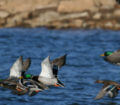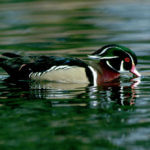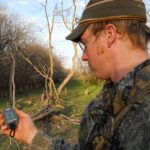John’s Note: Okay, in my opinion, I consider hunting ducks a different sport than shooting ducks. Shooting ducks means you go to a body of water, put out a bunch of decoys, have a retriever in the blind and wait for the ducks to fly by, so you can call them to within gun range. Hunting ducks involves bushwhacking them, learning where ducks live, eat and sleep and developing a stalking strategy to get in close enough to the ducks to jump shoot them when they come off the water. I’m not brazen enough to declare one technique better than the other. Actually I use both tactics throughout the season. But because duck shooting has become so sophisticated in many areas, duck hunting/ bushwhacking has begun to fade from popularity. Also, if you like to eat ducks as well as shoot ducks, there’s not a more-effective technique to bring waterfowl home for the table than bushwhacking.
 My wife and I existed on a subsistence living while in college and graduate school at the University of West Alabama, but we always had plenty to eat. Most of the meat we ate, we either caught or shot, and we grew most of our vegetables. If I had a bad week of hunting and fishing, we ate peanut-butter-and-jelly sandwiches. Only 15 minutes from our married students’ apartments, I hunted the Tombigbee River swamps. I learned those 8,000 acres better than I knew the chemical symbols and elements in my chemistry class. I became a proficient duck stalker.
My wife and I existed on a subsistence living while in college and graduate school at the University of West Alabama, but we always had plenty to eat. Most of the meat we ate, we either caught or shot, and we grew most of our vegetables. If I had a bad week of hunting and fishing, we ate peanut-butter-and-jelly sandwiches. Only 15 minutes from our married students’ apartments, I hunted the Tombigbee River swamps. I learned those 8,000 acres better than I knew the chemical symbols and elements in my chemistry class. I became a proficient duck stalker.
You don’t read very much today about stalking ducks. But you’ll find this tactic as exciting and as deadly as any form of duck hunting known to man. The backwater sloughs, oxbow lakes and wet-weather ponds off the Tombigbee River always loaded-up with floating acorns. During the fall and winter months, native wood ducks and migrating mallards ate these acorns for breakfast, lunch and dinner on these small waters just off the main river. Because this river-bottom flood plain homed an abundance of cypress and low-standing water, the ducks could see danger coming at great distances. I spent almost 2 years developing my stalking tactic of how I could get close enough to the ducks to get a shot without the ducks seeing me and flushing. My equipment consisted of:
* a backpack;
* lightweight, stocking-type waders;
* camo paint;
* a camo headnet and gloves;
* a camo hunting coat with a game pouch in the back;
* 15 to 20 shells (back then we only had 2-3/4-inch shells);
* a camo or dark brown or green belly boat; and
* a pair of old tennis shoes.
When I went into the woods, I’d listen for the high-pitched whistles of the wood ducks as they sat on the water or the quacking of the mallards feeding on the acorns. Once I heard the ducks, I’d try to determine my distance from them and what course I’d have to take to get within gun range. Next, I’d put on my waders and camouflage and slide into the water – well away from where the ducks fed.
 I learned that to get close to ducks I first had to move slowly to not leave ripples on the water, as I moved. I never shifted my weight from my back foot to my front foot, until my front foot had a firm and secure place on the bottom. I always tried to walk behind trees to remain out of sight of the ducks while I approached. I assumed that if I could see a duck, it could see me. Therefore, I remained motionless anytime I spotted waterfowl on the water. When I stopped for a break and to determine the ducks’ location, I always leaned up against a tree to resemble a part of the tree.
I learned that to get close to ducks I first had to move slowly to not leave ripples on the water, as I moved. I never shifted my weight from my back foot to my front foot, until my front foot had a firm and secure place on the bottom. I always tried to walk behind trees to remain out of sight of the ducks while I approached. I assumed that if I could see a duck, it could see me. Therefore, I remained motionless anytime I spotted waterfowl on the water. When I stopped for a break and to determine the ducks’ location, I always leaned up against a tree to resemble a part of the tree.
Often, if I spotted ducks close, but not within range, I’d try not to look at the ducks. Or, I’d close my eyes, so I barely could peek out of the slits, and the ducks couldn’t see my eyes. As I stalked, I estimated the amount of time required for me to walk from one tree standing in the water to the next tree, without the ducks spotting me. I had to discipline myself to move slowly enough to not spook the ducks by timing my stalk with a wristwatch. If I didn’t time myself, I’d move too fast and flush the birds I wanted to take.
 I also would designate a shooting tree. I decided I wouldn’t take a shot, until I reached a particular tree well within range of the ducks. Using this method, I knew if I spooked the ducks before I arrived at my designated shooting tree, I probably wouldn’t spook them bad enough so that they wouldn’t return to the same area within 10 or 20 minutes. When I reached the spot I planned to shoot from, I’d emerge from behind the tree. As the ducks came off the water, I would aim above them and usually get off three shots with my Remington 11-87 (https://www.remington.com/shotguns/autoloading/model-11-87) before the ducks climbed out of range.
I also would designate a shooting tree. I decided I wouldn’t take a shot, until I reached a particular tree well within range of the ducks. Using this method, I knew if I spooked the ducks before I arrived at my designated shooting tree, I probably wouldn’t spook them bad enough so that they wouldn’t return to the same area within 10 or 20 minutes. When I reached the spot I planned to shoot from, I’d emerge from behind the tree. As the ducks came off the water, I would aim above them and usually get off three shots with my Remington 11-87 (https://www.remington.com/shotguns/autoloading/model-11-87) before the ducks climbed out of range.
To learn some recipes for preparing ducks for the table, go to “The Best Wild Game & Seafood Cookbook Ever: 350 Southern Recipes for Deer, Turkey, Fish, Seafood, Small Game and Birds” at http://amzn.to/WkbLRg. For more information on hunting, check out John E. Phillips’ books at www.amazon.com/author/johnephillips for print, Kindle and Audible books and www.barnesandnoble.com.
















